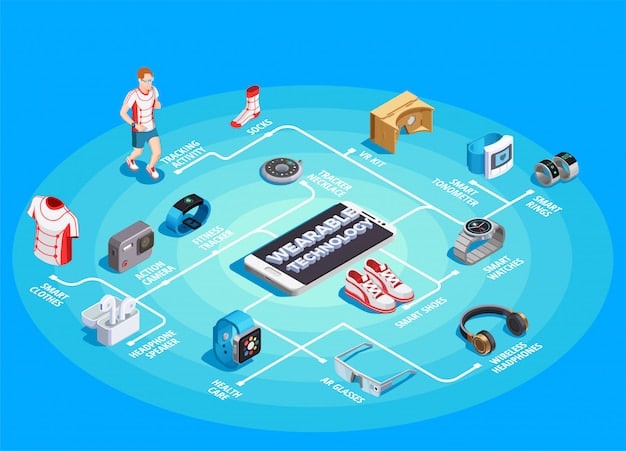Optimize Your US Wireless Network for IoT Devices: A Step-by-Step Guide

Optimizing your US wireless network for IoT devices involves assessing network capacity, enhancing security, selecting the right protocols, and implementing robust monitoring to ensure seamless and secure connectivity for all your IoT devices.
Is your US wireless network ready for the growing influx of IoT devices? Unlocking the full potential of IoT requires a robust and optimized wireless network.
Understanding the Landscape of IoT Devices in the US
The Internet of Things (IoT) is rapidly expanding in the United States, encompassing everything from smart home devices to industrial sensors. This growth places significant demands on wireless networks, requiring careful planning and optimization.
Let’s delve into the diverse range of IoT devices prevalent in the US market and the specific challenges they pose to wireless networks.
Popular IoT Device Categories
IoT devices vary greatly in their usage patterns, bandwidth requirements, and security needs. Understanding these differences is crucial for effective network optimization.
- Smart Home Devices: These include smart thermostats, lighting systems, security cameras, and voice assistants, often requiring continuous connectivity and low latency.
- Wearable Technology: Fitness trackers and smartwatches transmit health data and notifications, typically relying on Bluetooth or Wi-Fi for connectivity.
- Industrial Sensors: Used in manufacturing, agriculture, and logistics, these sensors monitor environmental conditions, equipment performance, and inventory levels, requiring reliable and long-range communication.
- Connected Vehicles: Cars equipped with navigation systems, infotainment features, and autonomous driving capabilities demand high bandwidth and low latency for real-time data transmission.
Successfully optimizing the network entails addressing each device category’s unique demands to guarantee overall performance. Tailoring the solutions accordingly facilitates efficient traffic management.
In conclusion, grasping the variety of IoT devices and their requirements is vital to planning an optimized wireless network. This knowledge allows you to implement tailored strategies that enhance system performance and security.

Assessing Your Current US Wireless Network Infrastructure
Before optimizing your wireless network for IoT devices, it’s essential to assess your current infrastructure and identify potential bottlenecks. This involves evaluating your existing hardware, network configuration, and security measures.
By analyzing key metrics, you can gain insights into your network’s performance and pinpoint areas that require improvement.
Key Network Metrics to Evaluate
Several metrics can provide valuable insights into your network’s health and performance. Monitoring these metrics regularly can help you identify and address issues proactively.
- Bandwidth Utilization: Measure the amount of data being transmitted and received on your network to identify periods of high traffic and potential congestion.
- Latency: Track the delay in data transmission between devices to ensure real-time responsiveness for critical applications.
- Signal Strength: Monitor the signal strength of your wireless network in different areas to identify coverage gaps and weak spots.
- Device Density: Assess the number of devices connected to your network to determine whether your current infrastructure can handle the increasing demand.
Thorough assessment of your current infrastructure combined with the collection of key network metrics lays the groundwork for strategic decisions to boost performance. By analyzing the data, you can pinpoint precisely where upgrades or optimizations are needed to boost device connectivity and security.
Ultimately, a clear understanding of existing gaps permits careful planning and implementation, boosting network competence for current and emerging IoT technologies.
Enhancing Security Measures for IoT Devices
Security is a paramount concern when integrating IoT devices into your wireless network. These devices often have limited processing power and memory, making them vulnerable to cyberattacks.
Implementing robust security measures is crucial to protect your network and data from potential threats, safeguarding privacy and operational integrity.
Implementing Network Segmentation
Network segmentation involves dividing your network into smaller, isolated segments to limit the impact of a security breach. This can be achieved by creating separate VLANs (Virtual Local Area Networks) for different types of devices.
Segmenting the network ensures that if one part is compromised, the damage is contained, minimizing effects on other areas.
- Isolate Critical Systems: Segment your critical systems, such as financial or healthcare data, from less secure IoT devices to prevent unauthorized access.
- Control Traffic Flow: Implement access control lists (ACLs) to restrict communication between network segments, allowing only necessary traffic to flow.
- Monitor Network Activity: Use network monitoring tools to detect suspicious activity within each segment and respond quickly to potential threats.
By establishing robust network segmentation strategies, you create a multifaceted security model that elevates resilience and safeguards critical data assets from potential threats.
In conclusion, enhancing security measures through segmentation provides a strong defense for IoT environments. With detailed knowledge and proactive implementations, organizations can confidently negotiate the security challenges of IoT without fear of extensive disruptions.

Selecting the Right Wireless Protocols
Choosing the appropriate wireless protocols is crucial for ensuring optimal performance and compatibility with your IoT devices. Different protocols offer varying levels of bandwidth, range, and power consumption.
Understanding the strengths and weaknesses of each protocol is essential for making informed decisions about your network configuration.
Comparing Wireless Protocol Options
Several wireless protocols are commonly used for IoT devices, each with its unique characteristics and applications.
- Wi-Fi (802.11): Suitable for high-bandwidth applications and devices that require internet connectivity, such as security cameras and smart TVs.
- Bluetooth: Ideal for short-range communication between devices, such as wearable sensors and smartphones, with low power consumption.
- Zigbee: A low-power, low-bandwidth protocol designed for mesh networks, suitable for smart home and industrial automation applications.
- Z-Wave: Another low-power mesh networking protocol commonly used for home automation, offering reliable communication and interoperability.
Carefully consider the selection of wireless protocol according to the application requirements because aligning protocols to device requirements ensures maximum operational efficiency.
In short, implementing the correct protocols to facilitate connectivity and optimize device function, guarantees a strong and secure framework for the IoT ecosystem.
Optimizing Network Configuration for IoT Devices
Optimizing your network configuration involves fine-tuning various settings to improve performance, reliability, and security. This includes configuring your wireless router, adjusting channel settings, and implementing quality of service (QoS) policies.
These configuration refinements are essential for ensuring smooth operation of your IoT devices and mitigating potential network disruptions.
Configuring Your Wireless Router
Your wireless router is the central hub of your network, so it’s essential to configure it properly for optimal performance.
- Update Firmware: Keep your router’s firmware up to date to patch security vulnerabilities and improve performance.
- Change Default Password: Replace the default password with a strong, unique password to prevent unauthorized access.
- Enable Wireless Encryption: Use WPA3 encryption to secure your wireless network and protect your data from eavesdropping.
By carefully optimizing your wireless router settings, you enhance the network’s resistance to potential threats and boost operational effectiveness.
To conclude, a well-configured router is a strategic point when it comes to managing traffic effectively and providing stable conditions. This means device communication is streamlined with very few performance challenges.
Monitoring and Managing Your IoT Network
Once you’ve optimized your wireless network for IoT devices, it’s important to monitor its performance and manage your devices effectively. This involves implementing network monitoring tools, establishing proactive maintenance schedules, and utilizing remote management capabilities.
Regular monitoring and proactive management are crucial for identifying and resolving issues before they impact your network’s performance.
Implementing Network Monitoring Tools
Network monitoring tools provide real-time visibility into your network’s performance, allowing you to identify and troubleshoot issues quickly.
- Traffic Analysis: Monitor network traffic to identify bandwidth bottlenecks and potential security threats.
- Device Status: Track the status of your IoT devices to ensure they are online and functioning correctly.
- Alerting: Set up alerts to notify you of critical events, such as device outages or security breaches.
- Reporting: Generate reports on network performance to identify trends and areas for improvement.
This results in swift insights and allows you to enhance performance and resolve potential problems before they impact the network.
In conclusion, combining innovative monitoring practices facilitates a resilient and scalable framework that promotes seamless operation. Knowledge through active monitoring enables an advanced approach where devices function optimally, reducing disruption so the network continues to execute properly.
| Key Point | Brief Description |
|---|---|
| 📊 Assess Network | Check bandwidth, latency, and device density. |
| 🛡️ Enhance Security | Implement network segmentation and update devices. |
| 📡 Select Protocols | Choose between Wi-Fi, Bluetooth, Zigbee, and Z-Wave. |
| ⚙️ Optimize Configuration | Update router firmware and enable encryption. |
Frequently Asked Questions
▼
Challenges include managing diverse device types, ensuring robust security, handling high device density, selecting appropriate wireless protocols, and maintaining reliable connectivity across varying environments.
▼
Network segmentation isolates different device groups, limiting breach impact. By controlling traffic and monitoring segments, unauthorized access is prevented, securing critical systems from compromised IoT devices.
▼
Bluetooth and Zigbee are excellent for low-power IoT devices. Bluetooth offers short-range connectivity, while Zigbee is suited for mesh networks in smart homes and industrial automation.
▼
Updating firmware patches security vulnerabilities, improves performance, and ensures compatibility with new devices and protocols. Regular updates maintain optimal network security and functionality, preventing exploitation.
▼
Network monitoring tools provide real-time visibility into traffic, device status, and potential threats. They enable traffic analysis, alerting, and reporting, leading to quick issue resolution and improved network functionality.
Conclusion
Optimizing your US wireless network for IoT devices is crucial for unlocking the full potential of connected devices. By assessing your infrastructure, enhancing security, selecting the right protocols, and implementing robust monitoring, you can ensure seamless and secure connectivity for all your IoT devices, fostering innovation and efficiency across your home or business.





